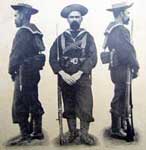Advanced Marks of Sea Service Accoutrements
or
Trials Patterns, Accoutrements, Naval, Pattern 1901?
COMPONENT PICTURES and DATA
The following is speculative. KWRT opinion is divided as to exactly what nomenclatures might have been used for this trial set. The Sea Service nomenclatures may, briefly, have had their Mark Numbers advanced by one. However, some items had dropped the Mark differentiation. For KW to advance them would create a second use of a previous Number, which is not ideal. The answer is simply to use New Pattern, or N.P., until such time as documentation emerges to provide more positive identification. The Navy appear never to have used the term, or Old Pattern, which were occasionally used by the Army and usually abbreviated to O.P. and N.P..
With only a few exceptions, the pictures on this page were taken from one of these sources:
(a) The cover of Under the Union Jack magazine, issue of 31st March 1900, showing three views of a seaman in rifle equipment.
(b) A postcard in the Backbone of the Navy series, showing another seaman, this time with pistol equipment.
(c) A second postcard in the Backbone of the Navy series, showing a tinted version of the right rear quarter view from the Union Jack cover (this picture, with the same background, was also used in a second series of postcards, in which it was titled A British Bluejacket of To-day).
(d) A cigarette card advertising Ogdens Guinea Gold Cigarettes, showing the front view from the Union Jack cover. Here the picture is titled One of our "Handy Men" of H.M.S. "Powerful".
Because the closeup shots can sometimes be hard to interpret, these four source photos are shown below, (a,b,c,d) left-to-right.
Bag, ammunition, leather. (N.P.)
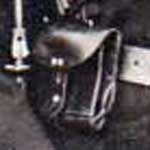 Both the Army and Navy made a distinction between “Pouch” and “Bag”, although they were completely opposite in sense! In the case of the Army’s Valise Equipment, it was to contain 30 rounds of loose ammunition, as a ready-use supply and worn below the Belt on the right front. When worn in the centre of the back, it was functioning more like the Navy’s “Bag”, which was what the Army sometimes called the “Magazine pouch”, i.e. containing the reserve ammunition, in packeted form.
Both the Army and Navy made a distinction between “Pouch” and “Bag”, although they were completely opposite in sense! In the case of the Army’s Valise Equipment, it was to contain 30 rounds of loose ammunition, as a ready-use supply and worn below the Belt on the right front. When worn in the centre of the back, it was functioning more like the Navy’s “Bag”, which was what the Army sometimes called the “Magazine pouch”, i.e. containing the reserve ammunition, in packeted form.
The Ammunition pouches here are clearly the Patt. ’01 “Bag” form, with a fold-away extension, tucked up behind the Pouch back. These contained packets of ammunition, the ready-use ammunition being in the Cartridge carrier. The folded extension, held by a secondary strap and stud, allowed greater quantities of ammunition to be carried, the semi-circular extension making the Pouch one-third deeper.
 The existing Belt for pouches was fitted with pull-up loops, back and front, sandwiched into the thickness of the Belt. This required adjustment buckles on both sides of the Belt, to keep the rear loops centrally located. Where it fastened with a snake buckle, the Belt for the cutlass was a simple, buckled Belt and this seems to have provided the new design here, which would have been cheaper too! Only two adjustment holes are visible, which on the 1901 pattern extended all along the centreline, where they served both as attachment points for the hooks on the Braces and for the single tongue of the rectangular, square-cornered buckle, which is of Patt. ’01 form.
The existing Belt for pouches was fitted with pull-up loops, back and front, sandwiched into the thickness of the Belt. This required adjustment buckles on both sides of the Belt, to keep the rear loops centrally located. Where it fastened with a snake buckle, the Belt for the cutlass was a simple, buckled Belt and this seems to have provided the new design here, which would have been cheaper too! Only two adjustment holes are visible, which on the 1901 pattern extended all along the centreline, where they served both as attachment points for the hooks on the Braces and for the single tongue of the rectangular, square-cornered buckle, which is of Patt. ’01 form.
 The Braces are doubled through loops fitted to the rear of the Bags, ammunition, the double-back being secured with a brass hook, in holes punched in the Brace. On the pistol rig postcard, it can clearly be seen that the doubled-back Braces act through a brass loop, to which is mounted a hook that fits the Belt adjustment holes. Neither the Holster, nor the Ammunition pouch, were equipped with loops, as were the Ammunition bags.
The Braces are doubled through loops fitted to the rear of the Bags, ammunition, the double-back being secured with a brass hook, in holes punched in the Brace. On the pistol rig postcard, it can clearly be seen that the doubled-back Braces act through a brass loop, to which is mounted a hook that fits the Belt adjustment holes. Neither the Holster, nor the Ammunition pouch, were equipped with loops, as were the Ammunition bags.
What cannot be determined is whether the new Braces were linked, in Patt. ’01 format. Also, the latest form of Sea Service Braces had a brass stud only on the front of the left Brace. This was to secure the upper end of the Cartridge carrier. There must be a similar stud fitted here, masked by the Haversack straps.
Carriage, water-bottle. (N.P.)
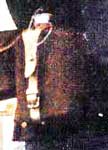 The then current Carriage was a skeleton framework, in the style of later webbing Carriers. The current Bottle, water, enamelled, naval. (Mark II.) was of round form, requiring a horizontal band to keep the bottle in place. The new Carriage was obviously a development of the naval belt-mounted concept, but was pared down to a single, vertical strap around the bottle, with the upper end split to accommodate the neck of the bottle. The broad, horizontal band of earlier Carriers could be dispensed with, as the bottle was now of rectangular front elevation. A secondary strap was attached to the rear strap and brought round under the bottle, where it was secured to a buckle and chape just below the stud for the securing strap. This second strap formed a belt loop, which allowed the whole assembly to be easily removed from the Belt, but kept it in place if only the bottle was to be removed. In the event, this new design was not adopted.
The then current Carriage was a skeleton framework, in the style of later webbing Carriers. The current Bottle, water, enamelled, naval. (Mark II.) was of round form, requiring a horizontal band to keep the bottle in place. The new Carriage was obviously a development of the naval belt-mounted concept, but was pared down to a single, vertical strap around the bottle, with the upper end split to accommodate the neck of the bottle. The broad, horizontal band of earlier Carriers could be dispensed with, as the bottle was now of rectangular front elevation. A secondary strap was attached to the rear strap and brought round under the bottle, where it was secured to a buckle and chape just below the stud for the securing strap. This second strap formed a belt loop, which allowed the whole assembly to be easily removed from the Belt, but kept it in place if only the bottle was to be removed. In the event, this new design was not adopted.
The new Carriage holds a Bottle, water, enamelled. (Mark V.), in its Cover, felt. This new form of bottle was not introduced by LoCs until 1st March, 1903. The 1901 LoC does state that it was “…of a new pattern, and particulars regarding it will shortly be published…” The bottle shape was a return to the outline and cross-section of the bottle used up to the end of 18th Century, with the tin-plating updated to enamelling. The unique spout was a new idea, presumably for ease of filling. The 18th Century reproduction at right is one of the superb range of products from tinsmiths Carl & Marcia Giordano at http://www.cg-tinsmith.com. The example of the Mk. V Bottle shown left is from the Chris Pollendine Collection, photo © Chris Pollendine 2011.
Carrier, cartridge, rifle, .303-inch. (N.P.)
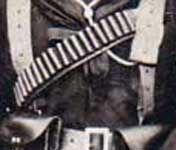 The Cartridge carrier is completely different to the previous patterns. The body is narrower and the four straps and studs, used to fit it onto the Belt, have been deleted. It can be speculated that this could have been achieved, by cutting off the lower edge of an existing Carrier, complete with the studs, hence the narrower form. It upper end, attached to the left Brace, is hidden by the Haversack strap. Previous practice had been to fit a stud here, onto which an eyeleted tab on the Carrier was buttoned. The left Patt. ’01 Brace had no stud. The opposite end is also hidden, where a strap served to attach the Carrier at the rear.
The Cartridge carrier is completely different to the previous patterns. The body is narrower and the four straps and studs, used to fit it onto the Belt, have been deleted. It can be speculated that this could have been achieved, by cutting off the lower edge of an existing Carrier, complete with the studs, hence the narrower form. It upper end, attached to the left Brace, is hidden by the Haversack strap. Previous practice had been to fit a stud here, onto which an eyeleted tab on the Carrier was buttoned. The left Patt. ’01 Brace had no stud. The opposite end is also hidden, where a strap served to attach the Carrier at the rear.
Where Sea Service Accoutrements employed two Carriers, the second worn around the front and right side of the belt. This was obviated by the use of two Ammunition bags. It was common practice to buckle the two Carriers into bandolier form, which probably set the precedent for the Patt. ’01 Bandolier. Development of charger loading was commenced in 1901, but Mark I Chargers were not announced until 11 May 1903, in LoC § 11753, approved 16 Jan 01.03 and 16 Feb 03. It was this that forced the adoption of the pocketed Patt. ’01 Bandolier.
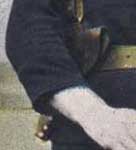 For some un-accountable reason, this is at completely at odds with all the Navy’s previous Holsters and later Cases. These were designed for wear on the left, for a cross-draw. The new design followed U.S. practice – if worn on the right – in that the butt is forward, requiring the back of the hand to be opposed to the wearer’s hip, in order to draw the pistol. If worn on the left – the normal naval position – it would force a left-handed draw, regardless of the wearer’s predilection, since a cross-draw would be impossible. It has been suggested that the right hand would be holding a cutlass. Neither the Holster nor the Ammunition pouch was equipped with brace loops. Following previous practice, since 1888, the Case was of riveted construction. It also looks longer than the then current Sea Service Webley Pistol case, as well as the later Patt. ’01 Case.
For some un-accountable reason, this is at completely at odds with all the Navy’s previous Holsters and later Cases. These were designed for wear on the left, for a cross-draw. The new design followed U.S. practice – if worn on the right – in that the butt is forward, requiring the back of the hand to be opposed to the wearer’s hip, in order to draw the pistol. If worn on the left – the normal naval position – it would force a left-handed draw, regardless of the wearer’s predilection, since a cross-draw would be impossible. It has been suggested that the right hand would be holding a cutlass. Neither the Holster nor the Ammunition pouch was equipped with brace loops. Following previous practice, since 1888, the Case was of riveted construction. It also looks longer than the then current Sea Service Webley Pistol case, as well as the later Patt. ’01 Case.
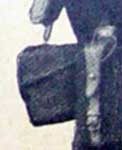
 Strictly speaking, “N.P.” is un-necessary, as no"O.P." existed. Not only that, but no earlier kit lists for Landing Parties included a Mess tin! So how did they cook? The form here seems to be Patt. ’01 form and is connected to the Haversack. It is assumed that belt loops were fitted, though this was not current Army practice with their oilskin Covers and only occurred when Patt. 1903 Bandolier Equipment was introduced. It may therefore be secured to the Belt only by the Mess tin strap. The Patt. ’01 form of Cover had four leather loops, two of them belt loops, the others orientated for the Mess tin strap to be passed around the Belt and through these loops.
Strictly speaking, “N.P.” is un-necessary, as no"O.P." existed. Not only that, but no earlier kit lists for Landing Parties included a Mess tin! So how did they cook? The form here seems to be Patt. ’01 form and is connected to the Haversack. It is assumed that belt loops were fitted, though this was not current Army practice with their oilskin Covers and only occurred when Patt. 1903 Bandolier Equipment was introduced. It may therefore be secured to the Belt only by the Mess tin strap. The Patt. ’01 form of Cover had four leather loops, two of them belt loops, the others orientated for the Mess tin strap to be passed around the Belt and through these loops.
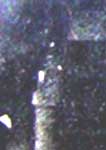
 On the rifle-armed sailor, the Bayonet frog is parallel-sided, so is clearly not any of the Sea Service Mark I to IV series. A prominent, central rivet is also visible above the scabbard loop, so this is of Patt. ’01 form, with its “shifting loop”. Further corroboration is present in the pistol rig postcard, where a cutlass is being carried. The Frog sides are assembled with three rivets – Patt. ’01 style - where the previous Marks III and IV used four rivets, but were also tapered Frogs.
On the rifle-armed sailor, the Bayonet frog is parallel-sided, so is clearly not any of the Sea Service Mark I to IV series. A prominent, central rivet is also visible above the scabbard loop, so this is of Patt. ’01 form, with its “shifting loop”. Further corroboration is present in the pistol rig postcard, where a cutlass is being carried. The Frog sides are assembled with three rivets – Patt. ’01 style - where the previous Marks III and IV used four rivets, but were also tapered Frogs.

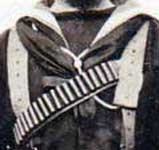 This is not of Patt. ’01 form, having straps for attachment to the Braces. The then current Haversack had no such provision, having been changed to buttoning belt loops. However, these were long enough to have fitted over the shoulder, but there was no narrow strap and button, as in Patt. ’01. There is also a secondary strap here, secured to the metal loop on the Mess tin strap. It is therefore a New Pattern, perhaps modified from the existing belt-carried type.
This is not of Patt. ’01 form, having straps for attachment to the Braces. The then current Haversack had no such provision, having been changed to buttoning belt loops. However, these were long enough to have fitted over the shoulder, but there was no narrow strap and button, as in Patt. ’01. There is also a secondary strap here, secured to the metal loop on the Mess tin strap. It is therefore a New Pattern, perhaps modified from the existing belt-carried type.
In the absence of specific attachment points,the straps are secured to the Brace adjustment hooks. The form that was adopted for Patt. ’01 was different, with a 50-inch shoulder sling, attached to buckles on both sides. It was also fitted with a 10 ½ x 1 ¼-inch “…fixed strap…” on the rear face, with four button holes and a single button. Its use remained un-explained, though these 1900 photographs show a logical application.
Pouch, cartridge, pistol. (N.P.)
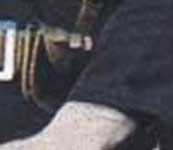 The capacity of the Patt. ’01 Pouch was 42 rounds, with six of these in external loops on the pouch flap, as here, the gusseted design also being new. From 1890, Sea Service pistol ammunition was in Cartridge carriers, comprising blocks of cartridge loops under three flaps. Now a return was made to a Pouch, but with the new feature of six ready-use cartridge loops.
The capacity of the Patt. ’01 Pouch was 42 rounds, with six of these in external loops on the pouch flap, as here, the gusseted design also being new. From 1890, Sea Service pistol ammunition was in Cartridge carriers, comprising blocks of cartridge loops under three flaps. Now a return was made to a Pouch, but with the new feature of six ready-use cartridge loops.
 As with the Cover, no prior example had existed, so “N.P.” is not strictly accurate. The Patt. 1901 form had a brass loop, stitched some 9-inches from the buckle, which placed it on top of the Mess tin, when the strap was buckled around the Cover. Though the purpose of this was not explained, it may have worked in conjunction with the Haversack’s “…fixed strap…”, which is assumed to hang vertically down from its base. Some form of “loop” connection is visible, between the Mess tin cover and Haversack.
As with the Cover, no prior example had existed, so “N.P.” is not strictly accurate. The Patt. 1901 form had a brass loop, stitched some 9-inches from the buckle, which placed it on top of the Mess tin, when the strap was buckled around the Cover. Though the purpose of this was not explained, it may have worked in conjunction with the Haversack’s “…fixed strap…”, which is assumed to hang vertically down from its base. Some form of “loop” connection is visible, between the Mess tin cover and Haversack.
Roger Dennis 2011
